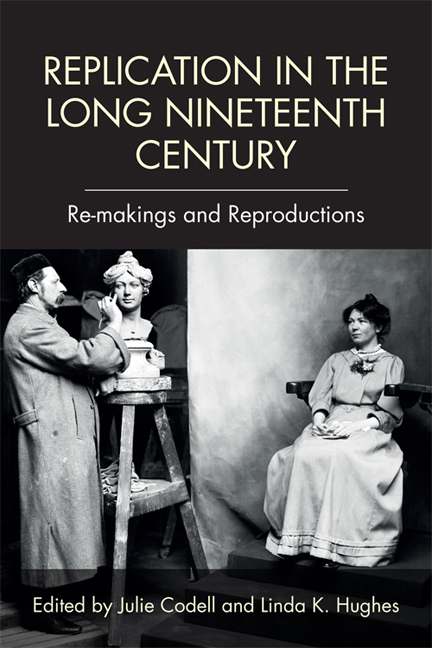Book contents
- Frontmatter
- Contents
- List of Illustrations
- Acknowledgments
- 1 Introduction: Replication in the Long Nineteenth Century – Re-makings and Reproductions
- I Replication and Networks
- II Replication and Technology
- 6 Replicating Tennyson's The Princess, 1847–1853
- 7 Paisley / Kashmir: Mapping the Imitation-Indian Shawl
- 8 William Morris and the Form and Politics of Replication
- 9 Text and Media Replication During the U.S.–Mexican War, 1846–1848
- III Replication and Authenticity
- IV Replication and Time
- Notes on Contributors
- Index
9 - Text and Media Replication During the U.S.–Mexican War, 1846–1848
from II - Replication and Technology
Published online by Cambridge University Press: 11 August 2018
- Frontmatter
- Contents
- List of Illustrations
- Acknowledgments
- 1 Introduction: Replication in the Long Nineteenth Century – Re-makings and Reproductions
- I Replication and Networks
- II Replication and Technology
- 6 Replicating Tennyson's The Princess, 1847–1853
- 7 Paisley / Kashmir: Mapping the Imitation-Indian Shawl
- 8 William Morris and the Form and Politics of Replication
- 9 Text and Media Replication During the U.S.–Mexican War, 1846–1848
- III Replication and Authenticity
- IV Replication and Time
- Notes on Contributors
- Index
Summary
The search for national identity in the U.S. spurred an expansive cultural movement to market patriotism during the 1840s. A brief, bloody war of aggression between the U.S. and Mexico (1846–8) served as a testing ground for the nation's power. Early victories at Palo Alto and Resaca de la Palma near Brownsville, Texas, on May 8 and 9, 1846, made General Zachary Taylor an instant hero and prompted President James K. Polk to declare war on Mexico a few days later, on May 13. The rapid spread of war news produced a viral phenomenon that responded to and helped to shape American desires for westward expansion, individual heroism, and indigenous democratic myths of the common man. Newspapers replicated battlefront reportage in cut-and-paste fashion, cross-pollinizing books, magazines, and commemorative objects such as “Palo Alto Hats” advertised in the New York Herald on June 16, 1846. Robert L. Johannsen describes the scene as a “war mood that approached hysteria”:
Heroes were molded and cast in the battle reports, the dispatches of newspaper correspondents, the soldiers’ letters, and the plethora of publications which the conflict generated. Their stories were told and retold until they became independent of reality. Their deeds were celebrated in poetry and song and were reenacted on the stage. When they were martyred, they were mourned with striking intensity. The first encounters with the enemy in May 1846 produced the war's first heroes and virtually every engagement after that added to the list.
(Johannsen 11–12, 113)Artists at lithography firms in New York and Philadelphia contributed to the effort by reimagining Mexican War scenes from the newspaper reports and replicating their art in lithographs to sell as individual prints or for use in other printed media or objects.
Mapping the migration of a specific set of images depicting the battle at Resaca de la Palma on May 9, 1846, demonstrates this process of replication across media and shows how replication by varied social networks of authors and artists produced the desire and meaning necessary for nation building and a sense of national identity.
- Type
- Chapter
- Information
- Replication in the Long Nineteenth CenturyRe-makings and Reproductions, pp. 162 - 178Publisher: Edinburgh University PressPrint publication year: 2017

